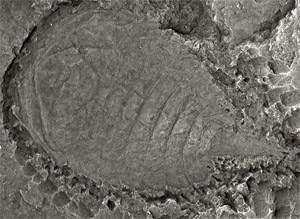The early arthropod fauna from Sirius Passet
Postdoc Martin Stein, Statens Naturhistoriske Museum, KU
On the second of July, 1984, just a day after the discovery of the celebrated Chengjiang Fauna in the Yunnan province of China, two geologists of the Geological Survey of Greenland found a trilobite amid the talus on a hillside in North Greenland. Little did they guess that this poorly preserved fossil should herald the discovery of another exceptionally preserved biota. And yet, back in Copenhagen, the Survey’s paleontologist John Peel should eventually discover evidence of exceptional preservation in samples collected from the site. He recognized the importance of the find in a time where the reinvestigation of the famous Burgess Shale was building up for a culmination in the publication of Gould’s Wonderful Life, while similar fossils were now being unearthed elsewhere in North America and the world.

Sirius Passet, as the fossil site and fauna was dubbed, was early on brought into the limelight of research around the ‘Cambrian Explosion’ with the Burgess Shale and Chengjiang biotas. This was in large part owed to a few controversy provoking studies of some of its most peculiar fossils in the light of major upheavals in our understanding of animal relationships. Ultimately, Sirius Passet was eclipsed by the seemingly incessant stream of new sensational discoveries from the Burgess Shale and Chengjiang. This may be because of the remoteness of the locality making it difficult to recover more material. Or it may be because of the limitations of preservation making the material particularly difficult to interpret. But, the fauna is far from having been exhaustively studied.
 Thirteen species of arthropods and lobopods have so far been
formally described from the fauna and three additional have
been reported; a modest number for the dominant animal
group in the fauna. But, survey of the massive, still unstudied
material in the collections hints at a higher diversity. I
want to present the known arthropod fauna of Sirius Passet,
its species’ role in discussions about arthropod phylogeny, as
well as give a glimpse of things yet to be described.
Thirteen species of arthropods and lobopods have so far been
formally described from the fauna and three additional have
been reported; a modest number for the dominant animal
group in the fauna. But, survey of the massive, still unstudied
material in the collections hints at a higher diversity. I
want to present the known arthropod fauna of Sirius Passet,
its species’ role in discussions about arthropod phylogeny, as
well as give a glimpse of things yet to be described.
Contact: Martin Stein
Time and place
The talk will take place 19:30 on Thursday 9 February at the August Krogh Building, Universitetsparken 13, 2100 Copenhagen Ø (Auditorium 1)
